Mark Langford's KP2S Project
First Engine Runs
created June 12, 2004
updated August 1, 2004
I finally got my Ellison EFS-3 in, after deciding to give the Weber a break.I'm not sure that there's anything wrong with it, but it bothered me not having immediate control over the mixture. The EFS-3 is now installed, and the big benefit is a mixture control. I spent the day running it, and I must say it's going to be perfect! It starts instantly (after it's been running), idles smoothly, and runs wide open just as smoothly. Mixture changes just a tad from dead stoichiometric to slighly rich, but I only know that because I have a sensitive air/fuel mixture gauge. The manual says you need a primer, and I'm beginning to believe it. It's pretty hard to start cold, because the carb doesn't flow any fuel until there's a substantial vacuum on the carb throat, and there's not accelerator pump. I'll probably order an electric primer solenoid and plumb it in next week.
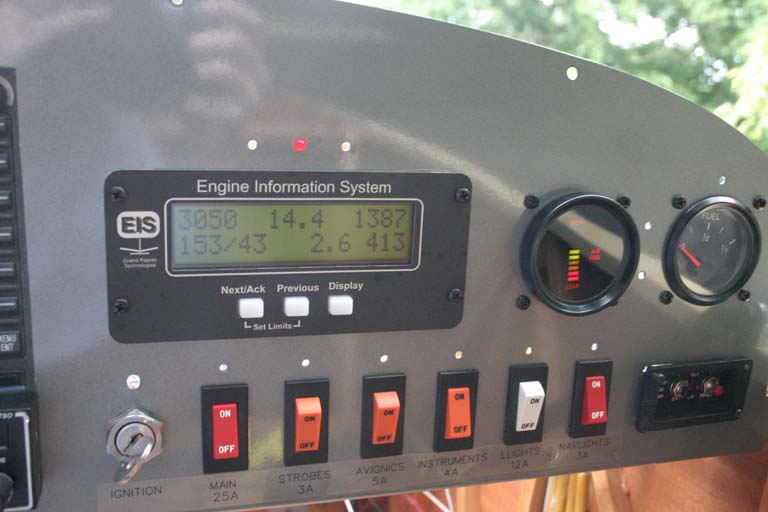
I ran it up to about 3000 this afternoon (the 3050 shown by the EIS is a spike). As you can see, the John Deere dynamo is charging nicely at 14.4 volts, highest EGT is 1387F, oil temp is 153 with 43 psi of pressure, 2.6 psi of fuel pump pressure, and highest head temp of 413 degrees F. Fuel pressure is about 6.1 psi with the engine off, 4.2 at idle, and drops to 2.6 wide open throttle (WOT). You can see the mixture gauge to the right of the EIS, slightly richer than perfect. I don't have any manifold pressure readings since I don't have that hooked up yet, but that's in the plan for tomorrow.
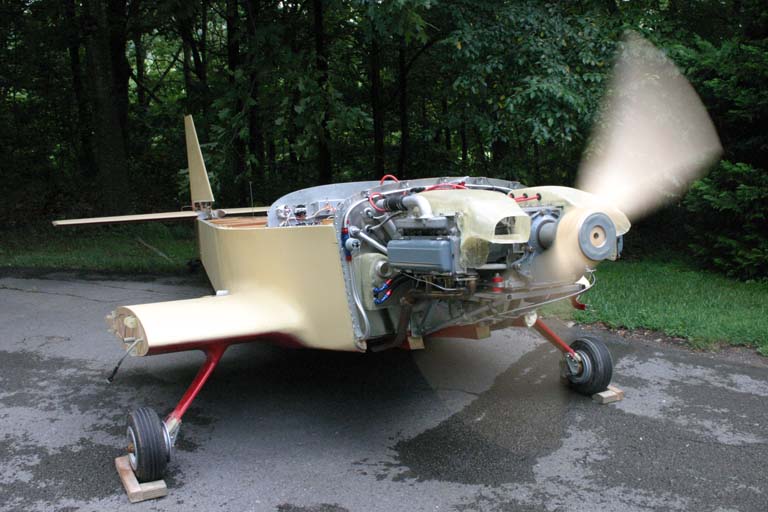 I ran it with the cowling on and off, and with the K&N air filter removed. It runs better with ram air, from what I can tell. I was able to spin my Sterba 52x66 up to 3000 rpm static. I was worried that I wouldn't be able to spin up to a high enough rpm at high speed, but Troy tells me his C-85/0-200 will turn his Sterba 2650 static, but spins up to 3300 at 230 mph. If I can gain 600 rpm too, I'll be turning 3600 rpm, which is certainly good enough for a starting point.
I ran it with the cowling on and off, and with the K&N air filter removed. It runs better with ram air, from what I can tell. I was able to spin my Sterba 52x66 up to 3000 rpm static. I was worried that I wouldn't be able to spin up to a high enough rpm at high speed, but Troy tells me his C-85/0-200 will turn his Sterba 2650 static, but spins up to 3300 at 230 mph. If I can gain 600 rpm too, I'll be turning 3600 rpm, which is certainly good enough for a starting point.
Last night I got everything ready to run, and thought I'd give the engine a try. I'd already set the timing statically (I'll never understand why some folks would rather goof around with the distributor while the engine's backfiring, looking for something close to correct timing), so it was within a degree or two of optimal already. Well, on about the third blade, it fired right up and idled smoothly for a few seconds until I shut it off. The only problem was I was still inside my basement, so it took about 15 minutes for the dust to settle down, and for me to clean up the mess!
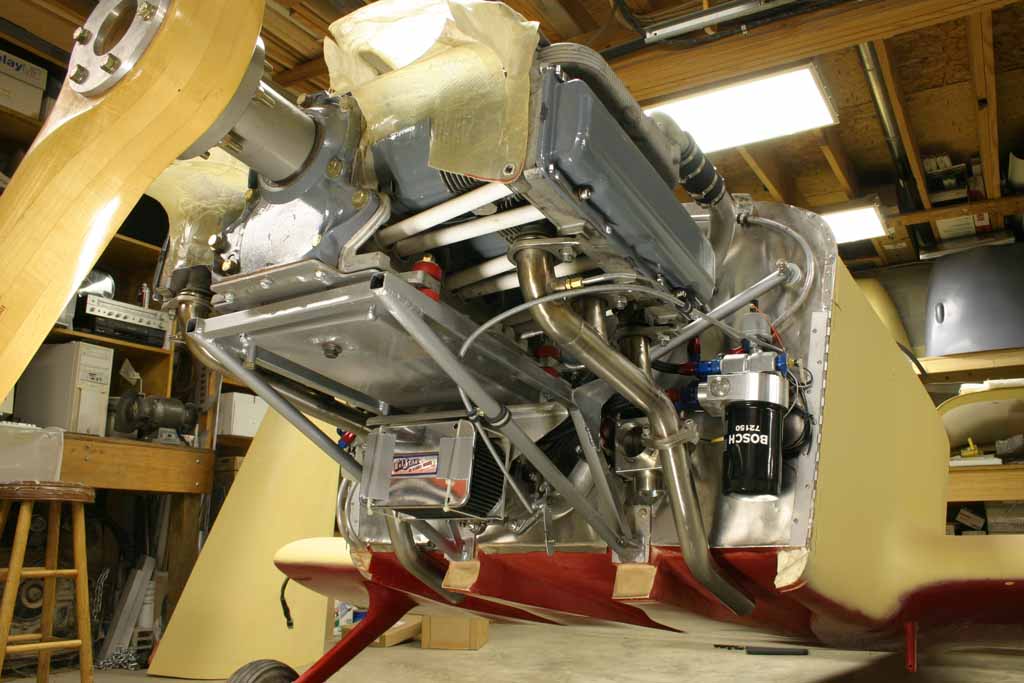
Here's what the engine looked like when I finally decided I was ready to run it. I hoaked up an air filter out of aluminum and an old old Weber air filter housing top. The carb is a Weber 40DCOE that I liberated from a 1967 1600cc Alfa Romeo, found in a German junkyard in 1977. It had two on it, so I also have a spare. I can't resist gloating that I paid $7 each for them! So it's not that I thought the Weber would be a perfect airplane carb, but in the automotive world, the Weber is considered to be the ultimate high performance carburetor. Only problem is that it doesn't have an inflight mixture adjustment, so that's a problem. The Weber has an enrichment device for cold starting, rather than the more typical "strangler choke" so I'm hoping to rig that as "normal", and the "choke" will become the leaning knob. Another possibility is controlling float bowl pressure, which I'll explore later if I have to.
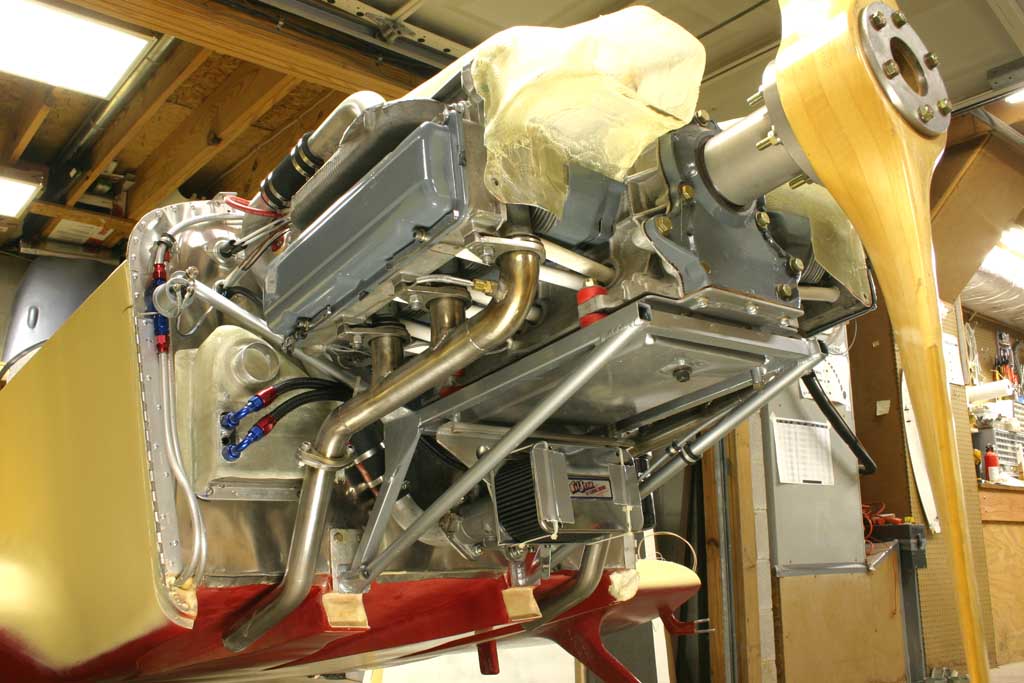
Here you can see the oil cooler and shroud on the passenger side of the firewall.
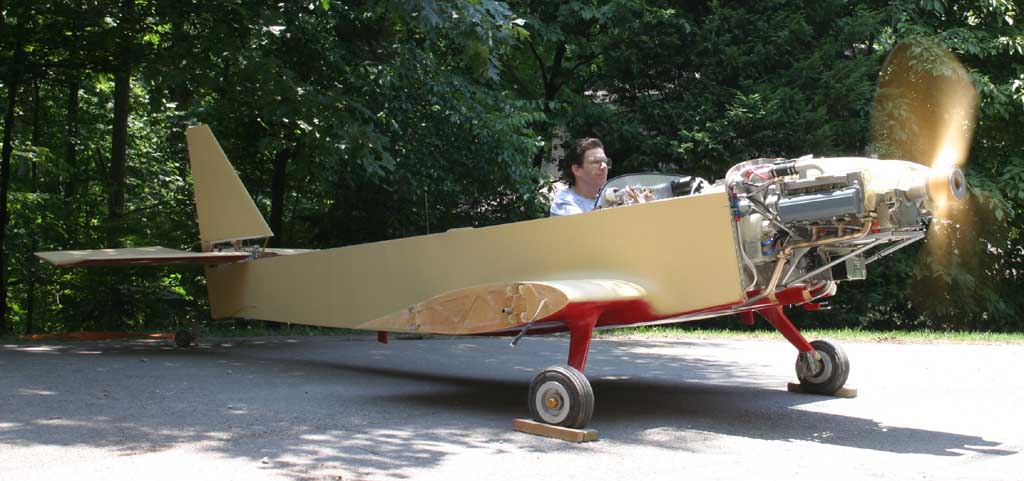
Today I took it outside, tied it to a tree, and ran it up for the first time. Again, it fired right up, but the air/fuel ratio gauge showed it running lean at idle, and extremely lean at midrange and high rpm.
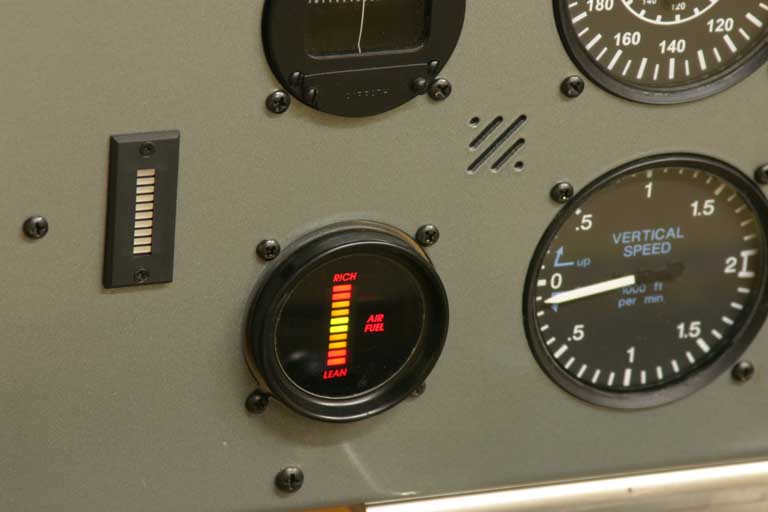
This is a Cyberdyne air/fuel gauge that I bought years ago for cheap. I think they've departed the scene now, but lots of folks make 'em now.
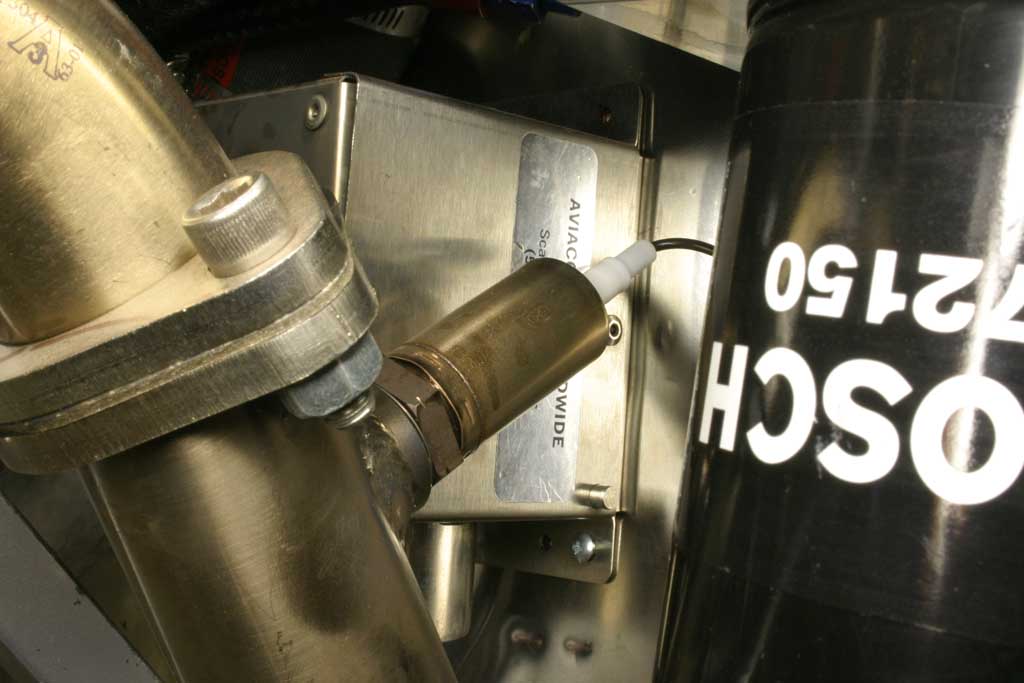
It uses a run-of-the-mill $30 Bosch "one wire" oxygen sensor with an 18mm thread. I welded a stainless boss that I got from Burns Stainless into the exhaust into the downtube.

The jets that came in Alfa were 110 mains, 180 air correction, and F16 emulsion tubes. I have 8 different Weber carbs that share those same jets, and the Karmann Ghia just happened to have the biggest ones on the property...so I tried them. 165 mains, 180 a/c, and F2 emulsion tube. This time, everything but idle was rich. So I split the difference and tried a 135 main, 180 air, and F11 emulsion tube that from some 40 IDFs from a 1600cc Fiat sedan in the same junkyard.
I adjusted the idle a bit also, after reading up to remind myself how to set those up (3/4 turns out and screw the adjustments in and then out and center them up where it runs best, then alter the idle speed adjustment screw to the right range, then repeat if necessary).
When I started it, I was amazed to see the air/fuel meter stuck to the center "perfect" mixture point almost throughout the range! I could actually fly this thing just like it was. And best of all, I didn't have to mess around with it for weeks like I thought I'd have to do! What really made it simple was that air/fuel ratio gauge. That threw all the guesswork away, and replaced it with concrete information that was easy to act on.
Only problem was, the EIS tach was reading 1200 rpm at a reasonably smooth idle, when I knew it was really a lot lower.
Time for a little data collection, so I checked max RPM with WW's loaner Sterba 54-67 cut-down prop. I managed to turn it at 5500 rpm. No, I didn't think you'd believe me, and I don't believe it either. That confirms the EIS is a little out of whack. My guess is that it's off by 1.5x, the difference between a 6 cylinder and a 4 cylinder.
But wait, I have a Tiny Tach too....but it's reading something like 6900 rpm, so I think there's a little problem with it too.
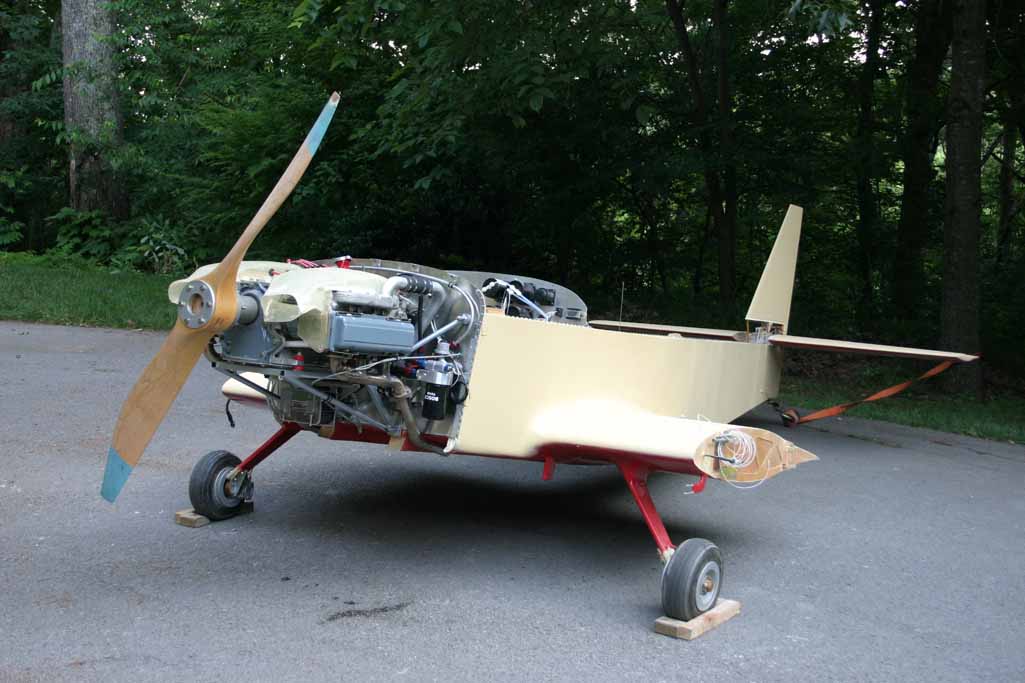 Needing a scale factor for RPM, I bolted on Doug Steen's 58x74 Aymar Demuth prop that I ran down at WW's Corvair 2002 College. I'd managed to turn it 2650 rpm on his test stand using a small-venturi A-65 carb, and was hoping for a slightly larger number with the Weber. Assuming that 66% ratio, I turned it 2900 rpm today, so that's just about in the ballpark. I've always thought that was too much prop, but it might just work depending on how it unloads at high speed. I'll have to check it against a high rpm Sterba, which I suspect will do a better job in the top end department. I think my Corvair's HP curve will beat the prop diameter efficiency curve to the extent that I'll get some pretty good speeds spinning the smaller prop fast, like 3800-4000 rpm for takeoff.
Needing a scale factor for RPM, I bolted on Doug Steen's 58x74 Aymar Demuth prop that I ran down at WW's Corvair 2002 College. I'd managed to turn it 2650 rpm on his test stand using a small-venturi A-65 carb, and was hoping for a slightly larger number with the Weber. Assuming that 66% ratio, I turned it 2900 rpm today, so that's just about in the ballpark. I've always thought that was too much prop, but it might just work depending on how it unloads at high speed. I'll have to check it against a high rpm Sterba, which I suspect will do a better job in the top end department. I think my Corvair's HP curve will beat the prop diameter efficiency curve to the extent that I'll get some pretty good speeds spinning the smaller prop fast, like 3800-4000 rpm for takeoff.
Return to Mark Langford's KR2S

 I ran it with the cowling on and off, and with the K&N air filter removed. It runs better with ram air, from what I can tell. I was able to spin my Sterba 52x66 up to 3000 rpm static. I was worried that I wouldn't be able to spin up to a high enough rpm at high speed, but Troy tells me his C-85/0-200 will turn his Sterba 2650 static, but spins up to 3300 at 230 mph. If I can gain 600 rpm too, I'll be turning 3600 rpm, which is certainly good enough for a starting point.
I ran it with the cowling on and off, and with the K&N air filter removed. It runs better with ram air, from what I can tell. I was able to spin my Sterba 52x66 up to 3000 rpm static. I was worried that I wouldn't be able to spin up to a high enough rpm at high speed, but Troy tells me his C-85/0-200 will turn his Sterba 2650 static, but spins up to 3300 at 230 mph. If I can gain 600 rpm too, I'll be turning 3600 rpm, which is certainly good enough for a starting point.






 Needing a scale factor for RPM, I bolted on Doug Steen's 58x74 Aymar Demuth prop that I ran down at WW's Corvair 2002 College. I'd managed to turn it 2650 rpm on his test stand using a small-venturi A-65 carb, and was hoping for a slightly larger number with the Weber. Assuming that 66% ratio, I turned it 2900 rpm today, so that's just about in the ballpark. I've always thought that was too much prop, but it might just work depending on how it unloads at high speed. I'll have to check it against a high rpm Sterba, which I suspect will do a better job in the top end department. I think my Corvair's HP curve will beat the prop diameter efficiency curve to the extent that I'll get some pretty good speeds spinning the smaller prop fast, like 3800-4000 rpm for takeoff.
Needing a scale factor for RPM, I bolted on Doug Steen's 58x74 Aymar Demuth prop that I ran down at WW's Corvair 2002 College. I'd managed to turn it 2650 rpm on his test stand using a small-venturi A-65 carb, and was hoping for a slightly larger number with the Weber. Assuming that 66% ratio, I turned it 2900 rpm today, so that's just about in the ballpark. I've always thought that was too much prop, but it might just work depending on how it unloads at high speed. I'll have to check it against a high rpm Sterba, which I suspect will do a better job in the top end department. I think my Corvair's HP curve will beat the prop diameter efficiency curve to the extent that I'll get some pretty good speeds spinning the smaller prop fast, like 3800-4000 rpm for takeoff.